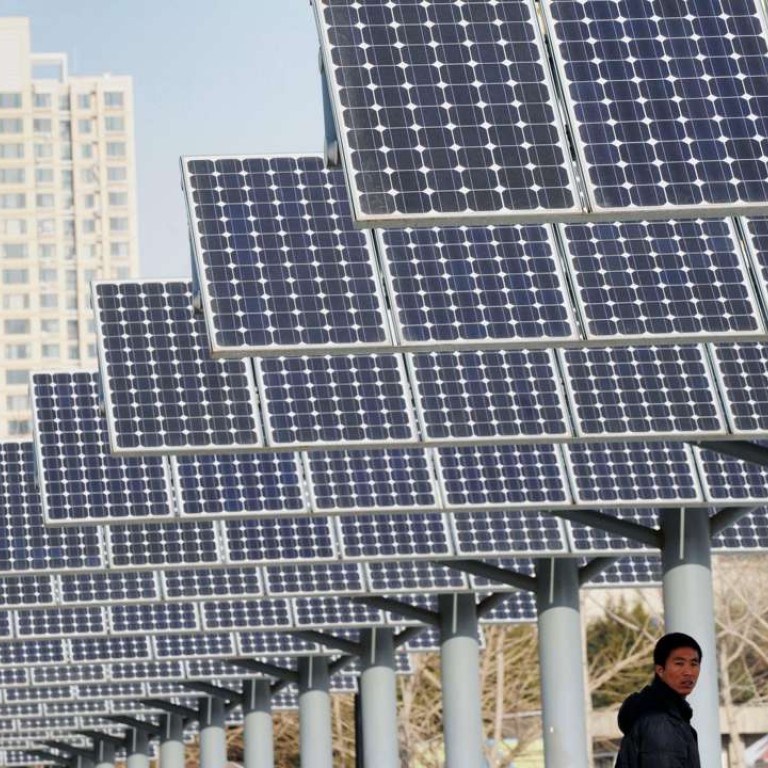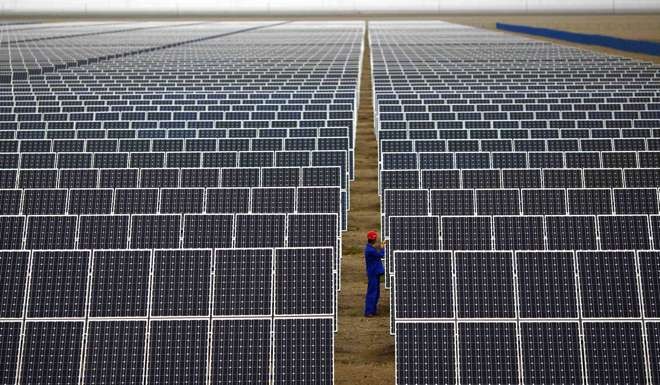
New | Strong progress by Chinese solar power generators will see subsidies eliminated by 2025
Senior official also says wind power subsidies likely to end by 2020
Chinese solar and wind power generators will be further weaned off their reliance on subsidies for growth, after meeting their technical goals quicker than expected, according to an industry regulator.
“Assuming no wastage of wind and solar power generated due to power grid bottlenecks, we had estimated that wind power will reach grid parity by 2020 and solar power by 2025,” Zhu Ming, the director of the National Energy Administration’s renewable energy department told the South China Morning Post on the sidelines of the China Photovoltaic Conference in Beijing on Wednesday.
“We now expect that to be reached faster, due to rapid technological advancement. The rising solar energy conversion efficiencies achieved will mean lower power production costs.”
Grid parity refers to the closing of the production cost gap between higher-cost renewable clean energy and that of the entire power generation industry, which in China is still dominated by highly polluting coal-fired power stations.
By that point, renewable energy will no longer require subsidies.
Zhu made the comment three weeks after the administration issued a draft document proposing to cut subsidised power tariffs of ground-mounted solar farms from the start of next year by between 23 and 31 per cent, depending on regions. The proposed cuts for off-grid solar farms, mainly roof-top ones, are to be cut by between 29 and 52 per cent.
Assuming no wastage of wind and solar power generated due to power grid bottlenecks, we had estimated that wind power will reach grid-parity by 2020 and solar power by 2025. We now expect that to be reached faster
Those proposals came as the industry recorded a record number of solar installation in the first nine months of the year, exceeding 27 giga-watts (GW) worth of power generation, according to China Photovoltaic Industry Association secretary general Wang Bohua.
That represented a 100 per cent year-on-year growth, and the result was also much higher than the full-year indicative target of 18 GW announced by the administration earlier this year.
China is already the world’s largest solar power installing nation, on both an annual and accumulative basis.
Wang warned, however, that such high growth was unlikely to be repeated, as the industry faces challenges including arrears in subsidy payments, rising land costs and power grid bottlenecks.
He said it is possible that full-year installation could reach 30 to 35 GW, compared with 15GW last year, as he expected the fourth-quarter volume to rebound after a “lull” in the third-quarter of just over 7GW.
The third-quarter dip came after a rush by developers to meet the June 30 deadline, after which subsidy tariffs were cut, resulting in 20GW of installation in the year’s first half.

Wang cited the target set by Jiangsu province-based panel maker Canadian Solar, to cut its production costs from US$0.39 in this year’s second-quarter, to US$0.29 per watt by the fourth quarter of next.
Beijing is also under pressure to reduce subsidised tariffs because of a growing deficit in its renewables fund, which finances the subsidies through surcharges on all power bills.
Despite repeated rises in the surcharges, the deficit is forecast to grow to nearly 60 billion yuan by the end of this year, said Frank Haugwitz, the founder of Asia Europe Clean Energy (Solar) Advisory in a report.
“A significant reduction in [subsidised tariffs] will certainly lower the fiscal burden in the years to come,” he wrote.
Arrears in the disbursement of some subsidies – the difference between renewable tariffs and the average power prices at the grid – are currently as long as three years, he noted, causing major strains on the cash flows of some solar farm developers.
To help relieve the burden, the administration last year launched the so-called “Top Runner” programme, through which large-scale projects were allocated to the most competitive developers and panel makers through open bidding.
It is hoped the programme will encourage industry-leading players to work harder on cost reduction, while at the same time meet minimum project quality requirements including solar panel energy conversion efficiency rates.
Three of the tenders launched recently went to bidders able to build projects at power prices 21 to 29 per cent lower than the benchmark subsidised tariffs, which offers the Chinese government further justification in its proposed subsidy cuts.
However, Wang argued such aggressive bids were partly driven by the strategy by some firms to boost market share by making losses on some projects during the third-quarter market lull, in the hope of winning more projects later.
“Such bids should not be interpreted as representative of the entire industry’s situation,” Wang said, hinting the photovoltaic industry association wants the tariff cuts to be less severe.
Lower land requisition cost and economies of scale from the huge size of the “Top Runner” programme also offer special cost advantages for the successful developers that are not repeated for the wider industry, he added.

